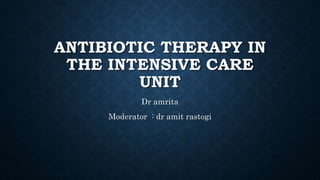
Antibiotic therapy in the intensive care unit [autosaved]
- 1. ANTIBIOTIC THERAPY IN THE INTENSIVE CARE UNIT Dr amrita Moderator : dr amit rastogi
- 2. THE ACTION OF ANTIMICROBIAL DRUGS Figure 20.2
- 3. PROTEIN SYNTHESIS INHIBITORS Figure 20.4
- 4. BETA LACTAMS • Narrow spectrum • Narrow spectrum pEnicillinase susceptible. Penicillin • Very-narrow-spectrum penicillinase-resistant drugs • Methicillin • Nafacillin • Oxacillin
- 5. • Wide spectrum • Wider-spectrum penicillinase-susceptible drugs • Ampicillin and amoxicillin. • Piperacillin and ticarcillin. • Wide spectrum pEnicillinase resistant drugs • Carbapenem • Imipinem • Meropenem • Doripinem • Ertapenem
- 7. OTHER CELL WALL INHIBITORS • Monobactams • Aztreonams • Vancomycin • Telavancin • Dalacin • teichoplanin
- 8. AMINOGLYCOSIDES • Gentamycin • Tobramcin • Amikacin • Toxicity profile • Ototoxicity • Nephrotoxicity • Blocking neuromuscular transmission • hypersensitivity
- 9. PROTEIN SYNTHESIS INHIBITORS • Linezolid • Quinupristin/Dalfopristin • Daptomycin • Tigecycline
- 10. ANTIMICROBIALS WITH ACTIVITY AGAINST ANAEROBES • Metronidazole • clindamycin
- 11. PHARMACOKINETICS AND PHARMACODYNAMICS OF ANTIBIOTICS
- 12. SPECIAL CONSIDERATIONS IN THE CRITICALLY ILL PATIENT • Volume of distribution • Metabolism • Clearance : ranal hyper and hypo filtration • hypoalbunaemia
- 13. HOW TO START • Loading dose = target plasma conc * volume of distribution • High loading doses for hydrophilic drugs like beta lactams , vancomycin , and aminoglycosides • Lipophilic drugs like macrolides,linezolid,tetracyclins do not require a high loading dose • Renal and hepatic function do not affect loading dose
- 14. PHARMACOKINETIC AND PHARMACODYNAMICS PROPERTIES OF ANTIBIOTICS • Minimum inhibitory concentration : The MIC is the lowest concentration of an antibiotic that completely inhibits the growth of a microorganism in vitro. While the MIC is a good indicator of the potency of an antibiotic, it indicates nothing about the time course of antimicrobial activity • Parameters quantifying serum level : • Peak serum level : Cmax • Trough level : Cmin • Area Under the serum concentration time Curve (AUC) : indicates the amount of drug
- 16. PARAMETERS INDICATING ANTIBIOTIC ACTIVITY • he Peak/MIC ratio, Cpmax divided by the MIC. • the T>MIC, percentage of a dosage interval in which the serum level exceeds the MIC. • and the 24h-AUC/MIC ratio. determined by dividing the 24-hour-AUC by the MIC
- 17. Pattern of Activity Antibiotics Goal of Therapy PK/PD Parameter Type I Concentration-dependent killing and Prolonged persistent effects Aminoglycosides Daptomycin Fluoroquinolones Ketolides Maximize concentrations 24h-AUC/MIC Peak/MIC Type II Time-dependent killing and Minimal persistent effects Carbapenems Cephalosporins Erythromycin Linezolid Penicillins Maximize duration of exposure T>MIC Type III Time-dependent killing and Moderate to prolonged persistent effects. Azithromycin Clindamycin Oxazolidinones Tetracyclines Vancomycin Maximize amount of drug 24h-AUC/MIC
- 18. DOSING OF A CONCENTRATION DEPENDANT ANTIBIOTIC
- 19. DOSING OF A TIME DEPENDANT ANTIBIOTIC • Multiple small dosing to obtain the maximum t > MIC • Role of prolonged infusions
- 20. ANTIBIOTIC RESISTANCE • Common mechanisms • Impermeability of the drug: • alteration in target molecules • enzymatic drug modifications • Efflux • both chromosomal mutations or genetic transfer ( plasmids ) can be responsible for the resistance acquisition,
- 21. FACTORS RESPONSIBLE FOR ANTIBIOTIC RESISTANCE • Lack of education • Hospital acquired infections • Use of antibiotics in agriculture or aquaculture • Environmental factors • Use in household products
- 22. SOME COMMON RESISTANT STRAINS : GRAM POSITIVE • Methicillin resistant Staplylococcus aureus (MRSA) • Vancomycin intermediate staph. Aureus ( VISA ) • Enterococcus- HLAR • Multi drug resistant strep pneumoniae
- 23. SOME COMMON RESISTANT STRAINS : GRAM NEGATIVE • Extended-Spectrum b-Lactamase –Producing Enterobacteriaceae • Antibiotic options carbapenems, • tigecycline • Carbapenemase producing enterobacteriaciae • The delhi metalloprotease • No susceptibility to any beta lactam or other higher antibiotics • Susceptible to tigecycline and colistin
- 24. • Multi drug resistant pseudomonas MDR P aeruginosa are strains that are resistant to 2 or more classes of antibiotics • Antipseudomonal Penicillins with or with out beta lactamases • Piperacillin tazobactum • Ticarcillin • Aztreonam • Caeftazidime in combination with aminoglycosides • Carbapenems : imipinem > doripinem > meropenem.etrapenem has no role against pseudomonas. • colistin
- 25. ANTIBIOTIC THERAPY IN THE ICU
- 26. ANTIBIOTIC STEWARDSHIP • The Centers for Disease Control and Prevention (CDC) estimates more than two million people are infected with antibiotic-resistant organisms, resulting in approximately 23,000 deaths annually. • Has recommended the setting up of special bodies in all acute care hospitals for the optimization of antibiotic use-called antibiotic stewardship programmes.
- 27. SPECIFIC INTERVENTIONS TO IMPROVE ANTIBIOTIC USE • formal procedure for all clinicians to review the appropriateness of all antibiotics 48 hours after the initial orders (e.g. antibiotic time out) • specified antibiotic agents need to be approved by a physician or pharmacist prior to dispensing • physician or pharmacist to review courses of therapy for specified antibiotic agents (i.e., prospective audit with feedback) • Automatic changes from intravenous to oral antibiotic therapy in appropriate situations • Dose adjustments in cases of organ dysfunction
- 28. • Dose optimization (pharmacokinetics/pharmacodynamics) to optimize the treatment of organisms with reduced susceptibility • Automatic alerts in situations where therapy might be unnecessarily duplicative • Time-sensitive automatic stop orders for specified antibiotic prescriptions • track rates of C. difficile infection • Monitor total amounts of antibiotics used
- 29. ANTIBIOTIC STRATEGIES TO COMBAT RESISTANCE Blast them
- 30. Fool them
- 32. ANTIBIOTIC STRATEGY FOR SKIN AND SOFT TISSUE INFECTION
- 34. ANTIBIOTIC STRATEGY FOR COMMUNITY ACQUIRED PNEUMONIA • A b-lactam (cefotaxime, ceftriaxone, or ampicillin-sulbactam) + azithromycin (level II evidence) or a respiratory fluoroquinolone • If Pseudomonas is a consideration • An antipneumococcal, antipseudomonal b-lactam (piperacillintazobactam, cefepime, imipenem, or meropenem) plus • either ciprofloxacin or levofloxacin (750 mg)
- 35. • Or • The above b-lactam plus an aminoglycoside and azithromycin • or • The above b-lactam plus an aminoglycoside and an antipneumococcal fluoroquinolone (for penicillin-allergic patients, substitute aztreonam for above b-lactam)
- 39. ANTIBIOTIC INFECTION FOR INTRA ABDOMINAL INFECTIONS
